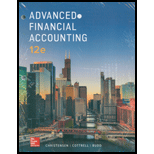
ADVANCED FINANCIAL ACCT.(LL) >CUSTOM<
12th Edition
ISBN: 9781260824292
Author: Christensen
Publisher: MCGRAW-HILL HIGHER EDUCATION
expand_more
expand_more
format_list_bulleted
Concept explainers
Question
Chapter 7, Problem 7.18AQ
To determine
Methods of Investment Accounting
There are two methods of investment accounting such as:
- Cost Method − This method is used when there is a long-term investment and ownership stake of less than 20%.
- Equity Method − This method is used when investment results in 20% to 50% stake in another company.
: The effect of each method of investment when there is unrealized intercompany gain on parent’s books.
Expert Solution & Answer
Want to see the full answer?
Check out a sample textbook solution
Students have asked these similar questions
You gave me unhelpful so i am also gave you unhelpful.if you will not give unhelpful then also i will not give unhelpful.
what is accoun?
Kling Company was organized in December Year 1 and began operations on January 2, Year 2. Prior to the start of operations, it incurred the following costs:
Costs of hiring new employees
Attorney's fees in connection with the organization of the company
Improvements to leased offices prior to occupancy (10-year lease)
Costs of pre-opening advertising
Required:
1. What amount should the company expense in Year 1?
600
$3,000
12,000
6,000
5,000
Chapter 12 Homework assignment take frame
Start-Up Costs
What amount should the company expense in Year 2?
+A
$
I need
Chapter 7 Solutions
ADVANCED FINANCIAL ACCT.(LL) >CUSTOM<
Ch. 7 - Prob. 7.1QCh. 7 - Prob. 7.2QCh. 7 - Prob. 7.3QCh. 7 - Prob. 7.4QCh. 7 - Prob. 7.5QCh. 7 - Prob. 7.6QCh. 7 - Prob. 7.7QCh. 7 - Prob. 7.8QCh. 7 - Prob. 7.9QCh. 7 - Prob. 7.10Q
Ch. 7 - Prob. 7.11QCh. 7 - Prob. 7.12QCh. 7 - Prob. 7.13QCh. 7 - Prob. 7.14QCh. 7 - Prob. 7.15QCh. 7 - Prob. 7.16QCh. 7 - Prob. 7.17QCh. 7 - Prob. 7.18AQCh. 7 - Prob. 7.1CCh. 7 - Prob. 7.2CCh. 7 - Prob. 7.3CCh. 7 - Prob. 7.4CCh. 7 - Prob. 7.5CCh. 7 - Prob. 7.1.1ECh. 7 - Prob. 7.1.2ECh. 7 - Prob. 7.1.3ECh. 7 - Prob. 7.1.4ECh. 7 - Prob. 7.1.5ECh. 7 - Prob. 7.2.1ECh. 7 - Prob. 7.2.2ECh. 7 - Prob. 7.2.3ECh. 7 - Prob. 7.2.4ECh. 7 - Prob. 7.2.5ECh. 7 - Prob. 7.2.6ECh. 7 - Prob. 7.3ECh. 7 - Prob. 7.4ECh. 7 - Prob. 7.5ECh. 7 - Prob. 7.6ECh. 7 - Prob. 7.7ECh. 7 - Transfer of Depreciable Asset at Year-End Pitcher...Ch. 7 - Prob. 7.9ECh. 7 - Sale of Equipment to Subsidiary in Current Period...Ch. 7 - Prob. 7.11ECh. 7 - Prob. 7.12ECh. 7 - Prob. 7.13ECh. 7 - Prob. 7.14ECh. 7 - Prob. 7.15ECh. 7 - Prob. 7.16ECh. 7 - Prob. 7.17ECh. 7 - Prob. 7.18ECh. 7 - Prob. 7.19ECh. 7 - Prob. 7.20ECh. 7 - Prob. 7.21ECh. 7 - Prob. 7.22ECh. 7 - Prob. 7.23AECh. 7 - Prob. 7.24PCh. 7 - Prob. 7.25PCh. 7 - Prob. 7.26PCh. 7 - Prob. 7.27PCh. 7 - Prob. 7.28.1PCh. 7 - Prob. 7.28.2PCh. 7 - Prob. 7.28.3PCh. 7 - Prob. 7.28.4PCh. 7 - Prob. 7.29PCh. 7 - Prob. 7.30PCh. 7 - Prob. 7.31PCh. 7 - Prob. 7.32PCh. 7 - Prob. 7.33PCh. 7 - Prob. 7.34PCh. 7 - Prob. 7.35PCh. 7 - Prob. 7.37PCh. 7 - Prob. 7.38PCh. 7 - Prob. 7.41AP
Knowledge Booster
Learn more about
Need a deep-dive on the concept behind this application? Look no further. Learn more about this topic, accounting and related others by exploring similar questions and additional content below.Similar questions
arrow_back_ios
SEE MORE QUESTIONS
arrow_forward_ios
Recommended textbooks for you
 Intermediate Accounting: Reporting And AnalysisAccountingISBN:9781337788281Author:James M. Wahlen, Jefferson P. Jones, Donald PagachPublisher:Cengage Learning
Intermediate Accounting: Reporting And AnalysisAccountingISBN:9781337788281Author:James M. Wahlen, Jefferson P. Jones, Donald PagachPublisher:Cengage Learning Auditing: A Risk Based-Approach (MindTap Course L...AccountingISBN:9781337619455Author:Karla M Johnstone, Audrey A. Gramling, Larry E. RittenbergPublisher:Cengage Learning
Auditing: A Risk Based-Approach (MindTap Course L...AccountingISBN:9781337619455Author:Karla M Johnstone, Audrey A. Gramling, Larry E. RittenbergPublisher:Cengage Learning- Principles of Accounting Volume 1AccountingISBN:9781947172685Author:OpenStaxPublisher:OpenStax College

Intermediate Accounting: Reporting And Analysis
Accounting
ISBN:9781337788281
Author:James M. Wahlen, Jefferson P. Jones, Donald Pagach
Publisher:Cengage Learning


Auditing: A Risk Based-Approach (MindTap Course L...
Accounting
ISBN:9781337619455
Author:Karla M Johnstone, Audrey A. Gramling, Larry E. Rittenberg
Publisher:Cengage Learning

Principles of Accounting Volume 1
Accounting
ISBN:9781947172685
Author:OpenStax
Publisher:OpenStax College